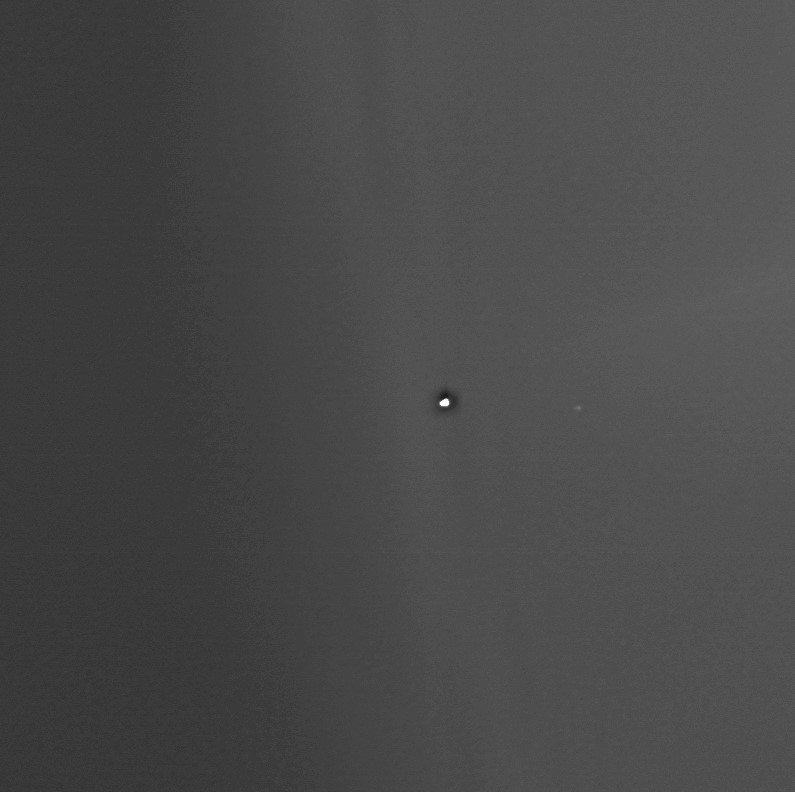When standing on Mars, observing Earth, a mixture of emotions wells up within because of awe. Over the course of several weeks, a small white dot circling around a larger dot could be noticed. That was the Moon gracefully orbiting Earth.
The European Space Agency's (ESA) Mars Express orbiter has captured remarkable images from a vast 300 million-kilometer distance WION reported. Although appearing indistinct initially, these photographs reveal the Earth and Moon, taken approximately 186.4 million miles away.

A sequence of four images taken by ESA’s Mars Express from Mars orbit capturing Earth and the Moon. The images were taken in celebration of the 20-year launch anniversary of Mars Express, which took place on 2 June 2023.
Mars Express Shares Image of the Pale Blue Dot on Its 20th Anniversary
Earth, famously described as a "pale blue dot" by Carl Sagan, continues to captivate us through images taken by space probes. Over three decades have passed since Voyager 1's iconic image, and now Mars Express joins the endeavor.
As per ESA's news release, the images captured by Mars Express's High Resolution Stereo Camera (HRSC) depict Earth and its moon as minuscule dots, emphasizing every living thing's collective presence and vulnerability. These snapshots, though humbling, serve as a reminder to prioritize the preservation of Earth as there is no Planet B.
While primarily used for observing Mars's moons and stars, the HRSC seized the opportunity to photograph Earth and its Moon during a series of dates in May and June 2023. The final image coincided with the 20th anniversary of Mars Express's launch, preceding a groundbreaking live broadcast of Mars images taken by the spacecraft's Visual Monitoring Camera (VMC).
These images hold no scientific value but commemorate the milestone of the mission. The first-ever planetary image taken by Mars Express captured the Earth-Moon system 20 years ago, a mere eight million kilometers away. By contrast, the recent images were taken from a staggering distance of approximately 300 million kilometers.
Looking to the future, Colin Wilson, ESA project scientist for Mars Express, envisions a time when humans will stand on the Martian surface and gaze upon Earth in the night sky. With ongoing and planned missions, such as the Rosalind Franklin rover and Mars Sample Return, ESA's commitment to Mars exploration paves the way for our ultimate ambition-human exploration.
Through these remarkable images and missions, the significance of our fragile home resonates deeply. They serve as a call to action, urging us to protect and cherish our pale blue dot, a precious oasis in the vastness of space.
READ ALSO: ESA's Mars Express Shares Stunning Photo of Christmas Craterscape in Mars
Photos of the Fuzzy Blob Serve as Reminders of Preserving Earth
The images evoke a reminiscent sentiment of Earth captured by Voyager 1 in 1990 during its journey beyond the confines of the Solar System, which was immortalized by Carl Sagan in his 1994 masterpiece, "Pale Blue Dot."
Sagan beautifully expressed the profound significance of the Voyager image, stating, "That's here. That's home. That's us. On it, everyone you love, everyone you know, everyone you ever heard of, every human being who ever was, lived out their lives."
As per Science Alert, Sagan eloquently captured the collective experiences of humanity, from their joys and sorrows to their diverse beliefs and roles throughout history, emphasizing that all of it transpired on a tiny speck of dust suspended in a beam of sunlight.
Two decades ago, Mars Express captured its first image of the Earth-Moon system while departing from a distance of 8 million kilometers. Since then, Mars exploration has advanced significantly, with ambitious plans for a future crewed mission to the Red Planet.
Mars Express remains a vital source of valuable data, providing intriguing revelations about our planetary neighbor and contributing to the preparation for upcoming missions.
RELATED ARTICLE: Red Planet's Geology: ESA's Mars Express Snaps Water-Carved Valleys, Deep Fractures [LOOK]
Check out more news and information on Space in Science Times.



![Earth's Quasi-Moon Kamo‘oalewa Could Originate From Lunar Surface Not Asteroid Belt [Study]](https://1721181113.rsc.cdn77.org/data/thumbs/full/53275/89/56/50/40/earths-quasi-moon-kamo-oalewa-could-originate-from-lunar-surface-not-asteroid-belt-study.png)










